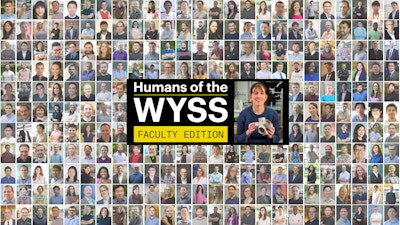The Humans of the Wyss series features members of the Wyss community discussing how they think about their work, the influences that help shape them as scientists, and their collaborations at the Wyss Institute and beyond.
In our first episode of the Faculty Edition, we talk to newly appointed Associate Faculty member Katia Bertoldi, Ph.D., in her laboratory in Cambridge, and learn about her interest in tunable materials and the ways they can impact different areas of life and research.
TRANSCRIPT:
LB: Welcome. We are here today with Katia Bertoldi. Great to have you here.
KB: Thanks.
LB: And we are here in your lab, which is new, which is quite exciting.
KB: Brand new.

LB: Why don’t you tell us a little bit about what type of research you’re doing here?
KB: Yes. So, I’m mainly interested in structures, but what I’m looking at is how we can exploit geometry of structures to achieve new properties and to design systems who’s property can be tuned and controlled on the fly.
LB: Interesting. So what applications would that have in real life?
KB: When we think about different structures, we can also think about reconfigurability. Think of this, for example, for medical applications. So, surgical devices, you would like to be able to go into the body, and then to expand to perform certain tasks. Or think about the ability to, for example, guided propagation of sound. You would like to be able to basically guide the propagation of sound in certain direction at a given time, and then at a given time you would like to create a barrier for sound to protect a certain environment.
LB: Right. So basically you want a structure to do one thing sometimes and do something else at other times?
KB: Exactly, exactly. There are different ways to achieve reconfigurability. One is to program the material itself, so to work basically with the chemistry. Basically, introduce smart molecules into the material, and then to control them with different stimuli. But another approach that we are basically exploring is the possibility to play with very simple materials, but play with geometry to achieve similar effect. And now we are trying to see how much we can push this.
LB: Okay, cool. And you brought some of those today. So, can you show us how these reconform and transform?
KB: Yeah, so for example, these are structures we designed with Chuck Hoberman who is also a researcher at the Wyss Institute. As you can see, it’s made with a very, very simple material, cardboard and adhesive tape. By carefully arranging these two building blocks, we can design the structure that can go from completely flat to fully expanded. And now I’m doing this with my hands, but what you can do you can embed actuators and we’ve done that so basically, you can control the motion from outside.
LB: That’s really cool. And I can definitely see how that’d be helpful for shipping. You want something to lie flat on a truck and then pop it up.
KB: Exactly. So you can actually achieve all sort of transformation by playing with geometry. Clearly, what we did, we developed algorithm towards being able to predict this geometry.
LB: So, what is it about the Wyss Institute that allows you to do all this interdisciplinary work in collaboration that you might not be able to do in other places?
KB: I think for me the Wyss is a very exciting and fascinating place, give me the opportunity to collaborate with a range of people with very different background. People that are very good at designing new materials, smart materials. People that are excellent at designing new robots. People who are focusing on architecture. So, it is quite unique to have all these people under the same umbrella. And now sort of support to basically pursue all these different research directions. I’m excited about the collaboration I’m having with Joanna [Aizenberg] and Jennifer [Lewis], where we try to combine smart material and complex geometries. We have also been working with Conor Walsh, Rob Wood and George Whitesides. We are mostly helping them with models, to predict basically the behavior of these robots. So, instead of using an empirical approach to design them, we are trying to develop methodologies to design robots with a predictable response.

LB: So speaking of robots, do you want to show us the snake robot?
KB: Inside there is a tube made of rubber, it’s an elastomer tube. So when we pump in air, it elongates in one direction. So now, in order to make it to move, what we did, we basically cover this actuator with the skin, and then we laser cut this pattern of cuts. And now what happens is, when it stretch, you see the cuts pop up. Opens up a little bit. Open up. So they create an asymmetry, and so, this basically makes this very simple machine to move. Basically, one actuator is enough to achieve a certain movement. So, it’s significantly simplify what is needed to achieve as basically locomotion.
LB: I know you just had a baby, so I’m sure that that takes a lot of your time.
KB: Yeah, we have two babies.
LB: Are there any things that you wish that you could reconfigure to make it easier to deal with your two kids?
KB: A stroller for my kids.
LB: Yeah, so if you can reconfigure a stroller what would you turn it into?
KB: I would like something very small that I can pack with me and bring it somewhere. Something much lighter than what it is, because right now, I mean it’s quite heavy.
LB: So maybe that’s a new project?
KB: That’s a new project for the future for sure.
LB: Bio-configurable strollers. Well, thank you so much for sharing your work with us today, Katia. It was really interesting.
KB: You’re welcome.
